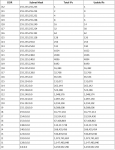BloodrayneZA
Well-Known Member
I"m really struggling to understand the maths behind this one. I have to get this sorted out as soon as possible.
I do understand this part though - say for example you have a 2^6 - 2. That's easy. It's 62.
It is the part where you have to calculate an higher number. it's nearly impossible to calculate 2^32 on a calculator. Also when you write the exam at a Pearson Vue testing center, you're not even allowed to have a calculator with you. At least last time it was in the fine print after purchasing the exam online. Counting on my fingers will not make things go any faster as there's a time limit on the exam and I have to complete it within that time frame. The exam centers do provide white boards and whiteboard pens.
Memorizing the whole table might be easier but at my age, I don't remember things as well as I used to. It took me a year to memorize my cell phone number (where 10 years ago I would be able to memorize it within a few weeks of constant use).
Maths has never been a strong subject - I've always failed it at school.
Any tips how to work it out in a short frame of time without a calculator or having to count on fingers?
PS. CIDR Notation sheet attached for reference. This is what I am supposed to be able to work on without the need for calculators or finger counting (which is probably inevitably involved anyway)
I do understand this part though - say for example you have a 2^6 - 2. That's easy. It's 62.
It is the part where you have to calculate an higher number. it's nearly impossible to calculate 2^32 on a calculator. Also when you write the exam at a Pearson Vue testing center, you're not even allowed to have a calculator with you. At least last time it was in the fine print after purchasing the exam online. Counting on my fingers will not make things go any faster as there's a time limit on the exam and I have to complete it within that time frame. The exam centers do provide white boards and whiteboard pens.
Memorizing the whole table might be easier but at my age, I don't remember things as well as I used to. It took me a year to memorize my cell phone number (where 10 years ago I would be able to memorize it within a few weeks of constant use).
Maths has never been a strong subject - I've always failed it at school.
Any tips how to work it out in a short frame of time without a calculator or having to count on fingers?
PS. CIDR Notation sheet attached for reference. This is what I am supposed to be able to work on without the need for calculators or finger counting (which is probably inevitably involved anyway)


